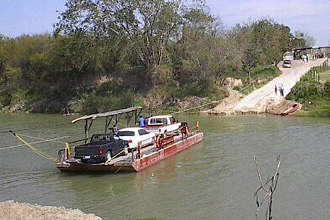 |
 |
 |
 News from Around the Americas | September 2007 News from Around the Americas | September 2007  
Border Ferry, Drawn by Hand, Remains Last of Its Kind
 Michelle Roberts - Associated Press Michelle Roberts - Associated Press
go to original


| | Only about 40 cars a day pass through Los Ebanos. |
Los Ebanos, Texas — Even in an age of laser visas and aerial drone patrols, this sleepy spot where the United States and Mexico meet on the Rio Grande has barely changed in two generations.

No steel bridge or wide lanes jammed with semi-trucks span the river. Instead, a small ferry shuttles pedestrians and cars, three at a time, between the sandy banks of both countries. It is powered only by five men pulling a rope and remains the last international ferry crossing on the southern U.S. border.

"It's almost as if time has stood still, and it continues to operate and function," said Ed Reyna Jr., the son of the farmer and local politician who started the ferry in 1950.

There has always been chatter among locals about replacing the ferry that spans this narrow section of the river with a more efficient bridge, but no plans have ever gotten off the ground, so the ferry just continues to run as it always has.

It operates seven days a week, weather permitting, from 8 a.m. to 3:30 p.m. If it's too rainy or windy or late in the day, crossers have to drive about a half hour to Rio Grande City.

"People call me all day when it starts raining," said Mark Alvarez, Reyna's nephew and the current ferry operator.

If there's no line, and the crew isn't on their 15-minute lunch break, it takes about 8 minutes to cross here. Passage costs 50 cents for pedestrians or $2.50 per car.

Only about 40 cars a day pass through Los Ebanos. By comparison, roughly 33,000 cars a day go north or south through the border in Laredo, which sits on a NAFTA-designated highway.

Still, this crossing is not untouched by the very modern concern of border security. Every car and person entering the United States here is checked by Customs and Border Protection agents who man a cinderblock shack whenever the ferry is operating. Like other checkpoints, they ask incoming people for residency documents and what they are bringing from Mexico.

Meanwhile, boat patrols cruise the Rio Grande looking for illegal crossers.

The ferry itself is subject to regular U.S. Coast Guard inspections to ensure it can traverse international waters, Reyna said, even though here "international waters" are just a shallow 25-yard span of the Rio Grande.

When the ferry is open, pedestrians clutching shopping bags and families in trucks or SUVs descend the rutted bank on the U.S. side and load onto the steel ferry, rebuilt last year after rust threatened its seaworthiness.

The crew leader counts every passenger, marking the numbers in a spiral-bound notebook, while five other men grab the rope pulled taut over the river's muddy waters and glide the ferry to Mexico.

There are only open fields across from Los Ebanos.

Passengers are greeted by an elderly man selling shaved ice and fresh-cut pineapple and melon from the back of a well-worn pickup truck. A single taxi waits for pedestrians who need a lift to Diaz Ordaz, a town of 15,000 people 1 1/2 miles to the south.

Los Ebanos hasn't always been a sleepy passage.

Spanish explorers used the ancient ford to export salt. Mexican troops crossed here in 1846 during border battles with the United States, and smugglers surreptitiously imported alcohol through here during Prohibition in the 1920s.

These days, most crossers at Los Ebanos are going to the U.S. post office or to do a little shopping in bigger border communities up the highway, Alvarez said. Los Ebanos itself is mostly a cluster of bedraggled single-family homes near to the riverbank.

Edgar Morin, a 25-year-old construction worker, has been riding the ferry since he was a child, mostly to run errands. On a day when he was headed to a doctor's appointment, he said riding the muscle-powered ferry is often quicker than heading to a bridge crossing.

"If you're coming on foot, it's quick," he said. "It saves me time and gas."

Reyna said that's the key to the ferry's continuation: people use it.

"How is this thing still possible in times of computers and people going to the moon and that sort?" he said. "I really don't have a good answer for that other than it's still a necessity in people's lives." | 
 | |
 |



